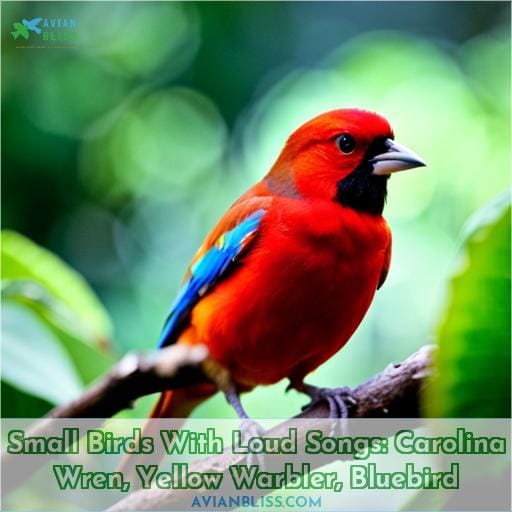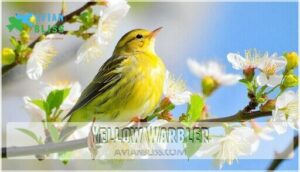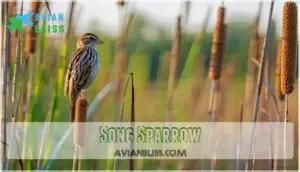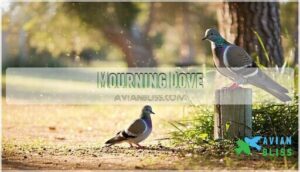This site is supported by our readers. We may earn a commission, at no cost to you, if you purchase through links.

Take the Carolina Wren, Yellow Warbler, and Bluebird – these three tiny songsters have notes as sweet as they are strong! In this article, we will explore why these small birds with loud songs have become fan favorites in backyards across North America.
Table Of Contents
Key Takeaways
- Birdsongs are awe-inspiring in volume and power.
- Small birds exhibit melodic songs.
- The Carolina Wren has a distinctive, loud song for territory and mating.
- The Yellow Warbler is a small bird with a buzzy, straw-like song.
Carolina Wren
You’ve likely heard the surprisingly intense song of the tiny Carolina Wren, barely two inches long yet boasting a distinctive melody that belies its miniature stature. Perching on branches and raised surfaces, the Carolina Wren’s rolling, vibrant, loud song emanates enthusiastically from its tiny body.
Rivaling even larger species like Yellow Warblers in volume during the breeding season, the male Carolina Wren sings its unmistakable song repeatedly to establish territory and attract females. With a varied repertoire, these petite songbirds switch between melodious whistles, sharp chatter, and buzzy trills.
Their small size allows Carolina Wrens to explore brush piles and cavities that bigger birds cannot, building globe-shaped nests in odd spots, like hornet nests. Resilient and adaptable, Carolina Wrens thrive near human habitation. Though tiny, they make their presence known with an energetic, ear-catching song that stands out among the warbling of Bluebirds and calls of Mourning Doves.
From backyard bird feeders to city parks, keep an ear out for the Carolina Wren’s song, and you’re sure to discover one of these vocal virtuosos.
Yellow Warbler
You were just immersed in the spirited song of the Carolina Wren, now open your eyes and ears to the bright warble of the Yellow Warbler.
Though small, the Yellow Warbler makes its presence known. Watch for a flash of golden feathers and listen for its buzzy, straw-like song.
Here are three remarkable traits of this tiny troubadour:
- Long Distance Flyer: It migrates from winter grounds in Central and South America all the way to breeding areas across North America.
- Pest Control: It consumes insects like beetles, caterpillars, and aphids, helping control agricultural pests.
- Nest Protector: Females aggressively defend nests, even mobbing much larger animals that venture too close.
Let the lively tune of the Yellow Warbler brighten your day. It’s a small bird with a big voice that brings cheer wherever it goes.
Bluebird
Fore hearing that bluebird’s whistles lasting over ten seconds, you could easily mistake its color-changing feathers for the American robin’s. However, bluebirds produce a distinctive series of whistles, spanning from 10 to 20 seconds in length.
Behavior:
- Nesting: Cavity nesters that readily use bird boxes.
- Song: Clear whistles and warbles lasting up to 20 seconds.
- Migration: Partial migrators that winter in southern North America.
- Diet: Omnivores that eat insects, spiders, fruits, and seeds.
- Habitat: Open country with scattered trees and fences for perching.
Bluebird populations declined in the 20th century but made an impressive comeback through dedicated conservation efforts, including nest box programs. While hearing a bluebird’s extended whistling song, take a moment to appreciate their melodious voice and admire their vibrant plumage.
These sightings are a testament to the power of ecological restoration.
Song Sparrow
Keep listening for that tseet in the bushes – the song sparrow’s spirited tune brightens any stroll through the trees.
This little brown bird with a red-orange chest flits between branches, belting out its trademark song. Variations abound between individuals and regions, but that tseet always punctuates the melody.
Pay attention and you may spot a male singing to defend its territory or attract a mate. Song sparrows prefer brushy areas and forest edges where they can nest hidden near the ground. Though adaptable, their numbers are declining with habitat loss, so enjoy the song while you can.
If you pause to appreciate the energetic trills, you may get a glimpse of this vocal virtuoso. Let its optimistic song lift your spirits as you explore the outdoors. With attentive listening, the diverse voices of nature’s smaller members still come through loud and clear.
Mourning Dove
Wretched Mourning Doves sob out their woeful cries at ridiculous volumes across the land.
Nests are hastily constructed with flimsy twigs, often collapsing and eggs are lost. Scavenging fallen seeds with no care for proper foraging. Shameless public mating displays lacking all subtlety.
The boorish Mourning Dove displays the least respectable qualities among birds. Their dolorous moans elicit not sympathy but frustration. We mustn’t judge them too harshly. Even as their coarse crooning grates our ears, it speaks to an inner longing we all share – to be heard, however imperfectly.
Thus, let us temper our scorn with compassion. However vexing their cries, perhaps they simply long for a response, for connection, as do we all.
Conclusion
From the tiny House Wren to the bright Yellow Warbler, the variety of bird species with loud, complex songs is astounding. In fact, these little birds possess some of the most melodic and intricate songs in the avian world.
Whether you’re listening to the Carolina Wren’s distinctive sound or the Yellow Warbler’s straw-like song, these small birds with loud, powerful songs demonstrate the remarkable variety of Mother Nature’s musicality.








